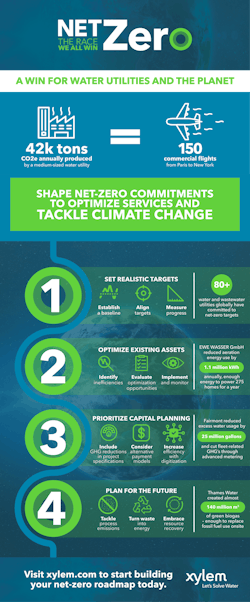The Push to Decarbonize Water & Wastewater Utilities
During WEFTEC 22 in New Orleans, Xylem released a whitepaper titled “Net Zero: The Race We All Win” to share the practical and pragmatic ways utilities can make adjustments toward a carbon-neutral future. It also provided some technologies that could overcome those challenges.
“We typically think about the water sector as a sustainable sector, and here we are contributing to global greenhouse gas emissions,” said Austin Alexander, Xylem vice president of sustainability. “Last year, we made our own commitment as a company and realized pretty quickly how important it will be to bring water and wastewater utilities along on this journey.”
A Journey, Not a Destination
For Alexander, the term journey is a critical one. Decarbonization looms as a daunting prospect for many facilities. The term “Net Zero” carries a lot of weight and requires resources, time, energy and labor to get right, but Alexander noted that utilities can start small to reach the carbon neutral goals they strive to meet.
In fact, there are utilities that are already on that path and have conducted some interesting work. One of the case studies shared in the whitepaper — and outlined by Alexander — is Southbend, Indiana. In reaching for its decarbonization goals, it also found operational efficiencies that improved the bottom line and reduced expenses.
“Optimizing their wastewater collection system not only prevented combined sewer overflows, but it also just helped run their entire system a lot more efficiently but cutting down energy use costs that had greenhouse gas emissions,” Alexander said, noting overflows are not only a community issue but also a regulatory one.
Meeting regulatory obligations and protecting the environment go hand-in-hand with decarbonization, Alexander said. As greenhouse gas emissions are reduced, the environment is improved. More optimal energy use not only reduces costs but also lowers emissions and improves environmental conditions as a result.
By tying those environmental improvements to the operational and cost efficiencies, Alexander said utilities have started to see the benefits with their systems. More importantly, she said, it also plays well with utility stakeholders, such as city councils, county boards, the public, and other governing bodies.
'Use What You Got Smarter'
“There is no silver bullet. There is no one technology that covers it all because emissions touch literally every piece of your operations,” Alexander said.
Pumps, blowers and disinfection equipment — on-site generation and ultraviolet systems — are the three biggest contributors to energy pain points for utilities. These pieces of equipment need to run regularly to ensure water is safe to drink and that wastewater is properly treated. But Alexander said thinking outside the box can also net some interesting ideas on reducing a carbon footprint.
“From rolling your crew out to do service and meter reads all the way through to the emissions coming off of fertilizers that some utilities may sell. The whole gamut,” Alexander said. “For the first few steps, you can make changes using technology that’s readily available. Use what you’ve got smarter.”
She said the digital solution that Southbend implemented for finding efficiencies in its pumping network is one example. Utilities can also reduce GHG emissions from service vehicles by installing advanced metering infrastructure, an automated metering system that creates benefits beyond the bottom line, such as customer engagement, leak detection and better flow management. Even changing the speed of aeration blowers or installing newer more efficient ones can make a large difference.
Once those elements are addressed, then utilities should begin to look further down the road at 10-year and 20-year plans to reduce emissions and energy usage. That can take the form of new digesters and a co-digestion program to produce energy on-site to solar and wind energy programs for sustainable energy use that reduces emissions more indirectly.
Sustainable Hauling of Wastewater Biosolids
On a more interesting and futuristic note, the movement toward electric vehicles is posing an interesting efficiency for biosolids hauling sustainability for wastewater utilities.
While most large equipment uses gasoline or diesel energy, which ultimately results in emissions, the advent of electric trucks — even electric semi-trucks — presents an opportunity for reducing emissions when hauling and landfilling biosolids. In fact, there is even research being done to convert fats, oils and grease in sewers to biodiesel as a beneficial resource from wastewater treatment processes.
Alexander said incorporating those ideas will come later when the research and products are more well established.


